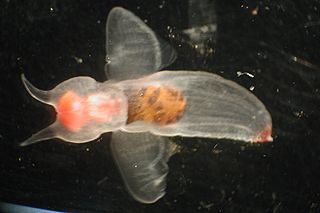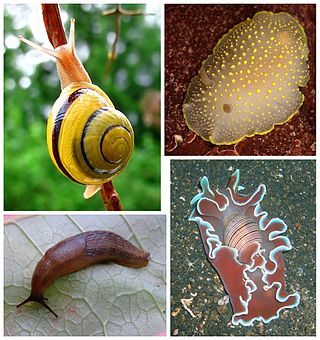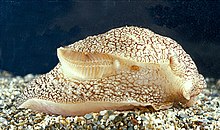
The gastropods, commonly known as slugs and snails, belong to a large taxonomic class of invertebrates within the phylum Mollusca called Gastropoda.

Chitons are marine molluscs of varying size in the class Polyplacophora, formerly known as Amphineura. About 940 extant and 430 fossil species are recognized.

Nudibranchs are a group of soft-bodied marine gastropod molluscs that shed their shells after their larval stage. They are noted for their often extraordinary colours and striking forms, and they have been given colourful nicknames to match, such as "clown", "marigold", "splendid", "dancer", "dragon", and "sea rabbit". Currently, about 3,000 valid species of nudibranchs are known.

Sea angels are a large group of small free-swimming sea slugs, not to be confused with Cnidarians, classified into six different families. They are pelagic opisthobranchs in the clade Gymnosomata within the larger mollusc clade Heterobranchia. Sea angels were previously referred to as a type of pteropod.

Sea slug is a common name for some marine invertebrates with varying levels of resemblance to terrestrial slugs. Most creatures known as sea slugs are gastropods, i.e. they are sea snails that over evolutionary time have either completely lost their shells, or have seemingly lost their shells due to having a greatly reduced or internal shell. The name "sea slug" is most often applied to nudibranchs, as well as to a paraphyletic set of other marine gastropods without obvious shells.

Opisthobranchs is a now informal name for a large and diverse group of specialized complex gastropods which used to be united in the subclass Opisthobranchia. That taxon is no longer considered to represent a monophyletic grouping.

Heterobranchia, the heterobranchs, is a taxonomic clade of snails and slugs, which includes marine, aquatic and terrestrial gastropod mollusks.

Sea snail is a common name for slow-moving marine gastropod molluscs, usually with visible external shells, such as whelk or abalone. They share the taxonomic class Gastropoda with slugs, which are distinguished from snails primarily by the absence of a visible shell.

Scutus breviculus is a common herbivorous species of large sea snail or limpet with the common name shield shell or less commonly duck's bill limpet. It is a marine gastropod mollusc in the family Fissurellidae, the keyhole limpets and slit limpets.

Umbraculidae are a taxonomic family of unusual sea snails or limpets, marine opisthobranch gastropod molluscs in the clade Umbraculida.

Umbraculum umbraculum, common name the umbrella slug, is a species of large sea snail or limpet, a marine gastropod mollusc in the family Umbraculidae. It is found in tropical to warm temperate parts of the Indo-Pacific and Atlantic Oceans, where it feeds on sponges.

Dotidae are a taxonomic family of small sea slugs, nudibranchs, shell-less marine gastropod molluscs formerly assigned to the order Opisthobranchia, but now considered to belong to the clade Dexiarchia.

Lepetelloidea is a superfamily of sea snails, small deepwater limpets, marine gastropod mollusks in the clade Vetigastropoda.

The Pleurobranchidae are a taxonomic family of sea slugs, marine gastropod molluscs in the clade Pleurobranchomorpha.
The taxonomy of the Gastropoda, as revised by Winston Ponder and David R. Lindberg in 1997, is an older taxonomy of the class Gastropoda, the class of molluscs consisting of all snails and slugs. The full name of the work in which this taxonomy was published is Towards a phylogeny of gastropod molluscs: an analysis using morphological characters.

Euthyneura is a taxonomic infraclass of snails and slugs, which includes species exclusively from marine, aquatic and terrestrial gastropod mollusks in the clade Heterobranchia.

Umbraculoidea is a superfamily of unusual false limpets with a thin soft patelliform shell, marine gastropod molluscs in the clade Umbraculida, within the clade Euopisthobranchia.
William B. "Bill" Rudman is a malacologist from New Zealand and Australia. In particular he studies sea slugs, opisthobranch gastropod molluscs, and has named many species of nudibranchs.

Ardeadoris averni is a species of sea slug, a dorid nudibranch, a shell-less marine gastropod mollusc in the family Chromodorididae. It was transferred to the genus Ardeadoris on the basis of DNA evidence.
Pleurobranchus varians is a species of sea slug, a sidegill slug, a marine gastropod mollusc in the family Pleurobranchidae.

















